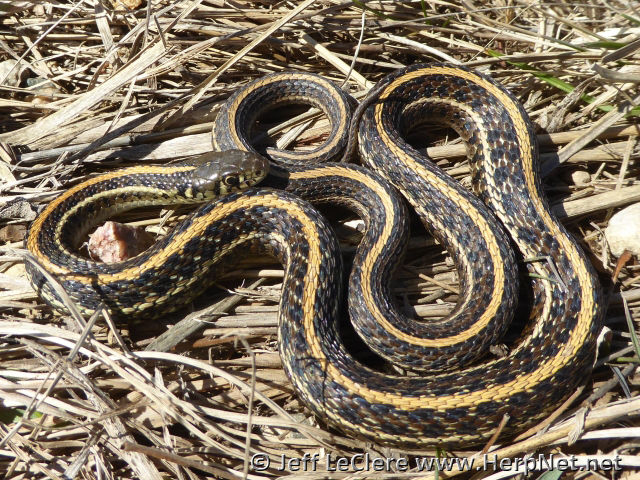Plains Garter Snake (Thamnophis radix)
Alternate names: Plains Gartersnake
by Jeff LeClere

Status
Species of Greatest Conservation Need. Garter snakes are afforded no protection in Iowa. Plains garter snakes are found statewide and are common.
Description
Harmless to humans. The plains garter snake is a medium sized Iowa snake measuring 14 – 43 inches in length (Conant and Collins, 1991). Plains garter snakes are the most heavy bodied of all Iowa garter snakes. It can be more docile than the common garter snake. The ground color is light brown to black with two alternating rows of black spots. Some specimens have an olive green background color in which the spots stand out especially well. Some populations have bright red pigment on the sides. I have seen reddish specimens in Linn, Mills, and several other Iowa counties.
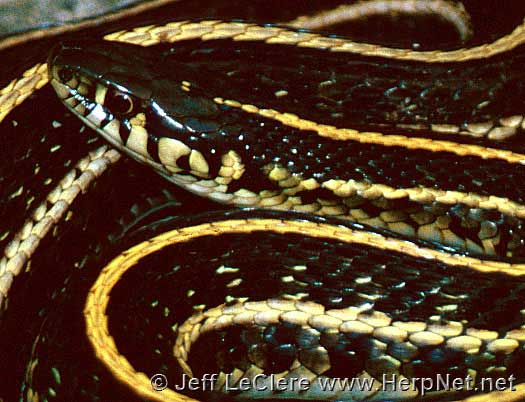
Plains garter snakes have three longitudinal stripes. The dorsal stripe is usually yellow or orange; some have an orange stripe anteriorly that changes to yellow before mid body and remains yellow to the tip of the tail. The lateral stripes are cream to yellow and are located on the third and fourth scale rows. There is usually a row of black spots below the lateral stripes at the edge of the ventral scales. The belly may be white, yellowish, or bluish. The head is brown or black with one or two small yellow dots near the parietals scales atop the head (these may be absent). There dark black bars on the labial scales. The scales are keeled and the anal plate is single.
The very similar common garter snake has the lateral stripes on rows two and three. Western ribbon snakes are more slender, have longer tails, and have white, unmarked labials.
Subspecies
None. No subspecies are currently recognized. There were formerly two weakly defined subspecies in Iowa, the eastern plains garter snake, Thamnophis radix radix, and the western plains garter snake, Thamnophis radix haydeni.
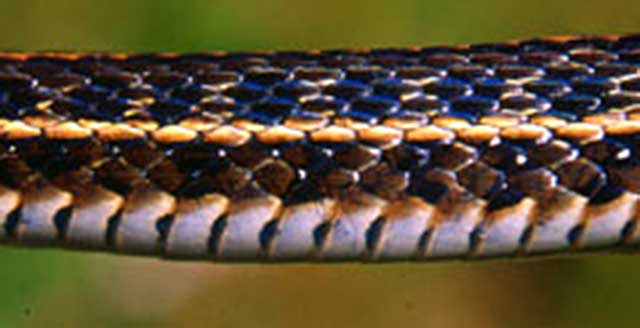
Range
The plains garter snake is found statewide in Iowa.
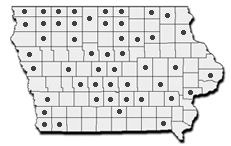
Habitat
The plains garter snake is one of Iowa’s most common snakes. They occur almost anywhere there is adequate food and shelter. They are extremely adaptable to environmental changes like the common garter snake. Unlike the common garter snake, however, the majority of plains garters prefer drier habitats, though a few individuals may be found at the waters’ edge. Open plains or grasslands on forest edges are favorite natural haunts. City parks, vacant lots, farmlands, or suburban backyards are also utilized.
Habits
This is a diurnal, active snake that is usually much less aggressive than the common garter snake. Instead of biting, it often expels a foul smelling musk and excrement to dissuade enemies. If cornered, it may hide its head under its coils, raise its tail in the air, and slowly wag its tail back and forth. Garter snakes are active thermoregulators and will alternately hunt and bask throughout the day. They take refuge underneath logs, rocks, boards, and in mammal burrows.
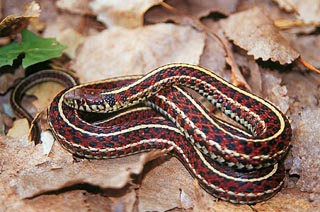
Plains garter snakes breed in the spring and the young are born alive in late summer or autumn. There may be 10 – 70 or more in a litter and are 5 – 8 inches in length. They may overwinter with other species of snakes and use any place they can get below the frost line. Road embankments, mammal burrows, and basements are common hibernacula. Young plains garter snakes may overwinter with redbelly and smooth green snakes in abandoned ant mounds.
Food
Plains garter snakes are voracious feeders and will eat anything they can catch and swallow, especially when warm. Earthworms, fish, frogs, toads, salamanders, mice, and birds eggs are consumed. These snakes may eat carrion. They eat their prey without constriction, thus they have strong jaws to overpower their prey.
